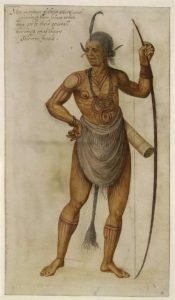Jamestown was founded in 1607 on land recently conquered by the Powhatan Confederacy. Movies about Pocahontas have given the impression that the “Powhatan Indians” were concentrated on the Chesapeake Bay. They were not. The villages on the coastline of the Chesapeake were the vassals of the Pamunkey Indians, who forged the confederacy. 1 The capital of the confederacy, Werowocomoco, was originally on the north side of the York River, not near Jamestown. Note that the town’s name ends with “moko” which is very similar to the Itza Maya title for king, mako, which was also used as a suffix by Itsate Creek Indians in Georgia and western North Carolina to signify a capital. Wahunsenacawh, (also known as Powhatan) the Weroance (commander) of the Powhatan is consistently portrayed as a illiterate, simple-minded “chief” of a primitive society. In fact, he was a highly intelligent leader of a dynamic indigenous society and the father of Pocahontas, who was known for her intelligence.

Opechancanough, the brother of Wahunsenacawh, could understand several European languages, plus was very familiar with European culture. 2 Pamunkey Indians told the Jamestown colonists that he had come to them as a noble of a land far to the southwest. 3 This is strong evidence that he was one and the same person as “Don Luis”, a son of a Virginia Indian chief, who was captured by the Spanish ship crew in 1561. 4 The ship then sailed to Spain. He spent five years in Spain, receiving a thorough education by the priests. He observed Spanish life and customs. He learned from the Jesuits and Franciscans how to write and also how to plan future events based on a calendar. The Creek Indians had an extremely accurate calendar which labeled each day. However, virtually all other indigenous peoples had no concept of all days having a unique labels.
Don Luis was then shipped to Mexico with a team of missionary priests where he spent three years, learning Spanish administrative techniques. There, he observed that the Native peoples had become second class citizens in their own land. He kept his observations to himself and bided his time.
He then returned to Spain where he continued his education with the Jesuits for another three years. The presumption in Spain was that he would eventually become a priest. When officials in St. Augustine were ready to establish a mission in the Chesapeake Bay area, Opechancanough was assigned to the team as an interpreter and priest’s assistant.
Eventually he was returned to his own land as a missionary and interpreter but when he returned to his own native ways (such as pre-marital intercourse) he was severely reprimanded and humiliated by the accompanying Jesuit priests. He eventually denounced Christianity and killed his Spanish allies.
Spanish archives record a curious statement made by one of Don Luis’s colleagues as to why a lay brother’s life was spared. He said that the lay brother was as much a victim of the friars as Opechancanough. Did one or more of the friars use the Indian lad, and the lay brother as homosexual concubines? It has certainly happened enough in the Catholic Church’s history. Sexual abuse might explain Opechancanough’s extreme hatred of the Spanish, even though “Don Luis” was treated as nobility while in the hands of the Spanish.
Opechancanough’s communication skills are very important for understanding what probably happened behind the scenes. In the early 1600s many Dutchmen would have understood Spanish and English, because of a century of domination by Spain and centuries of trade with England. It was not necessary for Dutch colonists to have personal contact with Opechancanough in order to communicate with him. Opechancanough could send and read letters!
Citations:
- Egloff, Keith and Deborah Woodward, First People: The Early Indians of Virginia, Charlottesville, VA: University Press of Virginia, 1992.[
]
- Rountree, Helen C. Pocahontas, Powhatan, Opechancanough: Three Indian Lives Changed by Jamestown. University of Virginia Press: Charlottesville, 2005.[
]
- Blair, John F., Jamestown, Williamsburg, Yorktown: The Official Guide to America’s Historic Triangle, 2007. p. 122-123.[
]
- Bridenbauh, Carl, Jamestown, 1544-1699, Oxford University Press, USA, 1980.[
]
